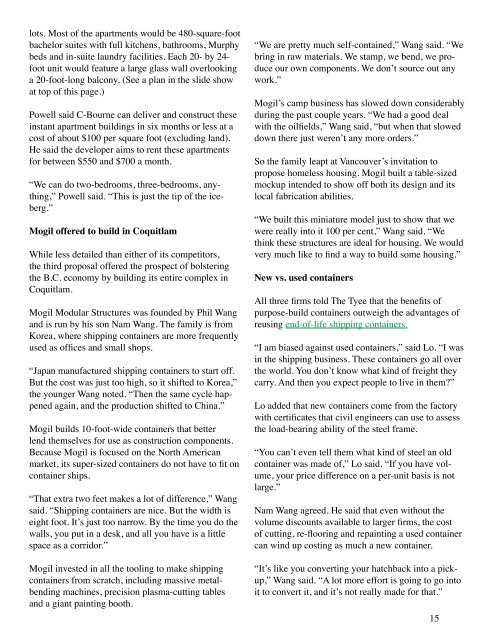from the ground up - The Tyee
from the ground up - The Tyee
from the ground up - The Tyee
Create successful ePaper yourself
Turn your PDF publications into a flip-book with our unique Google optimized e-Paper software.
lots. Most of <strong>the</strong> apartments would be 480-square-footbachelor suites with full kitchens, bathrooms, Murphybeds and in-suite laundry facilities. Each 20- by 24-foot unit would feature a large glass wall overlookinga 20-foot-long balcony. (See a plan in <strong>the</strong> slide showat top of this page.)Powell said C-Bourne can deliver and construct <strong>the</strong>seinstant apartment buildings in six months or less at acost of about $100 per square foot (excluding land).He said <strong>the</strong> developer aims to rent <strong>the</strong>se apartmentsfor between $550 and $700 a month.“We can do two-bedrooms, three-bedrooms, anything,”Powell said. “This is just <strong>the</strong> tip of <strong>the</strong> iceberg.”Mogil offered to build in CoquitlamWhile less detailed than ei<strong>the</strong>r of its competitors,<strong>the</strong> third proposal offered <strong>the</strong> prospect of bolstering<strong>the</strong> B.C. economy by building its entire complex inCoquitlam.Mogil Modular Structures was founded by Phil Wangand is run by his son Nam Wang. <strong>The</strong> family is <strong>from</strong>Korea, where shipping containers are more frequentlyused as offices and small shops.“Japan manufactured shipping containers to start off.But <strong>the</strong> cost was just too high, so it shifted to Korea,”<strong>the</strong> younger Wang noted. “<strong>The</strong>n <strong>the</strong> same cycle happenedagain, and <strong>the</strong> production shifted to China.”Mogil builds 10-foot-wide containers that betterlend <strong>the</strong>mselves for use as construction components.Because Mogil is focused on <strong>the</strong> North Americanmarket, its s<strong>up</strong>er-sized containers do not have to fit oncontainer ships.“That extra two feet makes a lot of difference,” Wangsaid. “Shipping containers are nice. But <strong>the</strong> width iseight foot. It’s just too narrow. By <strong>the</strong> time you do <strong>the</strong>walls, you put in a desk, and all you have is a littlespace as a corridor.”Mogil invested in all <strong>the</strong> tooling to make shippingcontainers <strong>from</strong> scratch, including massive metalbendingmachines, precision plasma-cutting tablesand a giant painting booth.“We are pretty much self-contained,” Wang said. “Webring in raw materials. We stamp, we bend, we produceour own components. We don’t source out anywork.”Mogil’s camp business has slowed down considerablyduring <strong>the</strong> past co<strong>up</strong>le years. “We had a good dealwith <strong>the</strong> oilfields,” Wang said, “but when that sloweddown <strong>the</strong>re just weren’t any more orders.”So <strong>the</strong> family leapt at Vancouver’s invitation topropose homeless housing. Mogil built a table-sizedmock<strong>up</strong> intended to show off both its design and itslocal fabrication abilities.“We built this miniature model just to show that wewere really into it 100 per cent,” Wang said. “Wethink <strong>the</strong>se structures are ideal for housing. We wouldvery much like to find a way to build some housing.”New vs. used containersAll three firms told <strong>The</strong> <strong>Tyee</strong> that <strong>the</strong> benefits ofpurpose-build containers outweigh <strong>the</strong> advantages ofreusing end-of-life shipping containers.“I am biased against used containers,” said Lo. “I wasin <strong>the</strong> shipping business. <strong>The</strong>se containers go all over<strong>the</strong> world. You don’t know what kind of freight <strong>the</strong>ycarry. And <strong>the</strong>n you expect people to live in <strong>the</strong>m?”Lo added that new containers come <strong>from</strong> <strong>the</strong> factorywith certificates that civil engineers can use to assess<strong>the</strong> load-bearing ability of <strong>the</strong> steel frame.“You can’t even tell <strong>the</strong>m what kind of steel an oldcontainer was made of,” Lo said. “If you have volume,your price difference on a per-unit basis is notlarge.”Nam Wang agreed. He said that even without <strong>the</strong>volume discounts available to larger firms, <strong>the</strong> costof cutting, re-flooring and repainting a used containercan wind <strong>up</strong> costing as much a new container.“It’s like you converting your hatchback into a pick<strong>up</strong>,”Wang said. “A lot more effort is going to go intoit to convert it, and it’s not really made for that.”15








